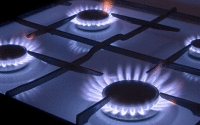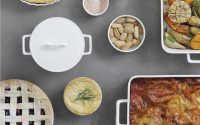Why Is the Stainless Steel Pan Ideal for Cooking and How to Choose the Right One
Posted in Kitchen Appliances By Valentina Lower On April 25, 2024Is there anything that a high-quality frying pan isn’t good for? Whether you’re a home cook or a professional chef, you need the skillet for frying, sautéing, making stocks and brews or casseroles, to name a few. Its curved sides and relatively light weight allow for effortless stirring and tossing of ingredients for quick, even cooking. It also performs an excellent job of roasting smaller pieces of meat, fish, and vegetables, such as chicken breasts, steaks, chops, and more.
Of all available cookware materials, stainless steel is an absolute favourite. Why is this material ideal for a frying pan, and how can you choose the right one?
Pros and Cons of Steel Pans
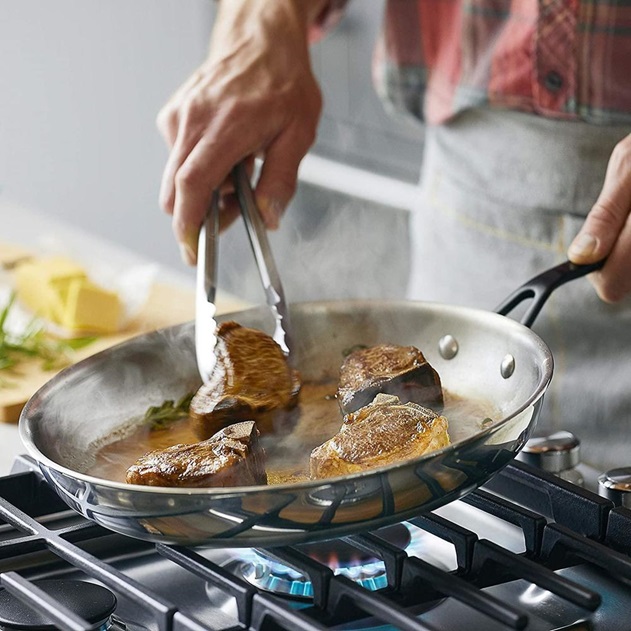
Every type of cookware has benefits and drawbacks; what suits one person may not suit another. As with all quality materials, stainless steel cookware has its price tag. Here are the pros and cons of high-quality steel frying pans to ensure that this skillet fits your lifestyle before investing.
Pros
Durable
Because of its strength and nearly impenetrable surface, stainless steel is incredibly resistant to dents, scratches, and corrosion. Because of this, these pans are sturdy and long-lasting. In most cases, using metal utensils on a surface doesn’t scratch or harm in any other way.
Long-lasting
If you take good care of it, stainless steel is so resilient that you can pass it on to the next generation. Not needing to replace your cookware every few years makes a steel frypan a sustainable option. Investing in premium stainless steel cookware from reliable brands is the best way to ensure longevity.
Heat Tolerance
When constructed properly, stainless steel works well for high-intensity cooking, such as searing steaks, because it can withstand temperatures up to 315°C without warping or emitting toxic fumes.
Versatile
Stainless steel works with most cooktops and is safe for use in the oven. Ferritic (low / zero nickel) stainless steel makes up the bases of most steel frying pans; therefore, they’re induction-compatible. However, you should double-check the product labels to be sure. Because of the adaptable handles, you may effortlessly transfer your food from the burner to the oven to complete it without having to use another pan.
Non Reactive
Because stainless steel contains chromium, it forms a non-reactive layer of chromium oxide on the pan’s surface. That guarantees that regardless of how acidic your ingredients are, they won’t react chemically with them or impart undesirable flavours. That makes stainless steel pans one of the safest and non-toxic pan alternatives.
Dishwasher Safe
Particularly after seasoning, stainless steel is quite simple to keep clean. It requires only simply rinsing and placing it in the dishwasher.
Cons
Heats Up Slowly
Stainless steel doesn’t conduct heat uniformly as other materials, creating hot areas that might result in uneven cooking. Moreover, it heats relatively slowly. Some brands fix that by overlaying or bonding stainless steel with another conductive material.
Food Stickiness
Food can adhere to the surface of stainless steel pans if you don’t use enough fat or preheat the pan to the proper temperature. That implies that cooking fat- or oil-free in stainless steel isn’t possible. It takes expertise and experience to determine when the stainless steel is ready to prevent food from sticking when using these pans for cooking.
Weight
Compared to nonstick or aluminium cookware, stainless steel cookware is frequently heavier. Some cooks love that because the pans are less likely to shift while cooking. However, people who have limited strength or movement may find this problematic.
How Do I Choose a Steel Frying Pan?
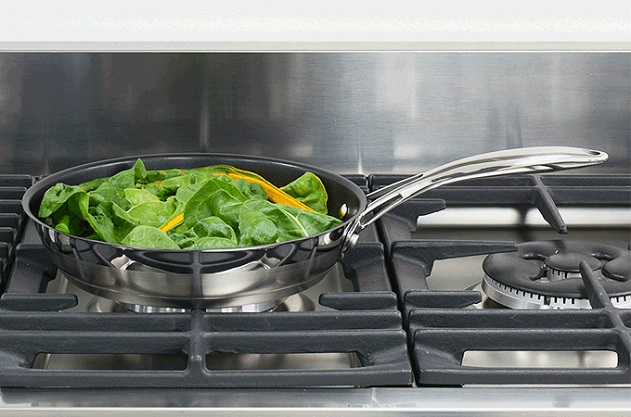
If you’re convinced that stainless steel frying pans are the ideal path for your culinary journey, the next step is to find one that’ll be right for your cooking endeavours.
Manageable Weight
Since steel fry pans are heavier than their counterparts, finding one with a manageable weight is crucial. Remember that you won’t use it only to move it around on the stovetop burner; it should not cause wrist strain when you pour from it or turn it over to discard its heated contents.
Conduction of Heat and Evenness
Although every pan has hot and cold patches, significant spots can cause uneven cooking, uneven browning, and difficult-to-clean food sticking to the skillet, especially when using preheated stainless steel cookware. To prevent this issue, read reviews that carefully note and document any hot or cold areas on the surface of the skillets.
Diametre
Although there are many other sizes of skillets, the 20, 26 and 30-32 cm sizes are the most popular. If this is your first time purchasing a skillet, err on the side of moderation. You can start with a 20- or 26-cm skillet. The 26-cm skillet is ideal for feeding three to four people, while the 20-cm pan is sufficient for cooking for one or two. For cooking in large quantities or entertaining a crowd, a 32-cm pan works well.
Thermal Capability
Seared steaks are the epitome of perfection when cooked in a high-quality stainless steel pan; if you occasionally prefer to finish your meal in the oven, stainless steel is excellent for baking since it absorbs heat quickly and evenly. If baking at higher degrees is crucial, use an oven-safe pan that can accommodate that temperature.
How to Master the Art of Cooking in Stainless Steel?
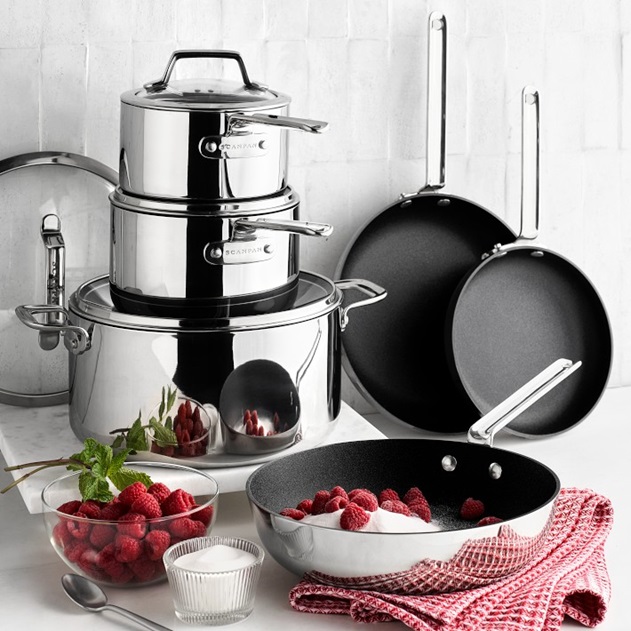
Knowing the correct procedures and techniques is crucial to completely using the potential of stainless steel cookware. Here are some helpful tips to help you become a stainless steel cooking pro.
Preheating
Heat retention and distribution uniformity are two essential features of stainless steel cookware. It’s important to warm your stainless steel pans before adding any ingredients to get the most out of this function. First, preheat the pan for a few minutes on medium heat. To see if the pan is ready, lightly mist the surface with a few drops of water. The pan is ready if the water droplets sizzle and evaporate immediately.
Add Butter or Oil
Use enough butter or oil when using a stainless steel frypan to keep food from adhering to stainless steel cookware. When the pan is hot, drizzle it with oil, or melt some butter and swirl it to cover the entire frying surface. Before adding any ingredients, let the butter or oil get hot.
Controlling Heat
Since stainless steel cookware reacts quickly to temperature fluctuations, managing the heat is critical. As you warm the pan, start at medium heat and modify it to suit the needs of your recipe. If you want to boil anything or sear the meat quickly, use high heat, but be careful not to burn delicate components. Because they can withstand sudden temperature changes while adding liquids, stainless steel pans work particularly well for deglazing.
Timing and Patience Are Key
When using stainless steel for cooking, patience is essential. Let the pan do the work; don’t stir or turn at all times. When moving or flipping veggies, let them caramelise and meats get a crust. That’ll facilitate enhanced browning and taste development while assisting in preventing sticking. Change the heat if necessary to prevent your food from burning or overcooking.
Maintenance and Cleaning
Keeping your stainless steel cookware clean and well-maintained is crucial to extend its lifespan. Let the pans cool down after every use before washing them. Steer clear of harsh cleaners or rough sponges that could harm the surface. Instead, clean any remaining food residue with a gentle sponge or cloth and warm, soapy water. If there are stains or burnt food residue, briefly immersing the pan in water can aid in dislodging the residue. You can keep your stainless steel cookware shiny and lustrous by polishing its outside regularly.
About Author
valentina

